What Signal#
Signal definition:
\[
x: \mathbb{R}^m \to \mathbb{R}^n
\]
in the following we present $\( x: \mathbb{R}^1 \to \mathbb{R}^1 \)$
Also we show Differentiate the signal and Integrate the signal over time.
import sympy as sp
import numpy as np
import matplotlib.pyplot as plt
# Define the symbolic variable for time
t = sp.symbols('t')
# Define the symbolic sound signal (e.g., a damped exponential signal)
x = sp.exp(-t) * sp.sin(2 * sp.pi * 5 * t)
# Differentiate the signal
x_derivative = sp.diff(x, t)
# Integrate the signal over time
x_integral = sp.integrate(x, t)
# Convert symbolic expressions to numerical functions for plotting
x_func = sp.lambdify(t, x, "numpy")
x_derivative_func = sp.lambdify(t, x_derivative, "numpy")
x_integral_func = sp.lambdify(t, x_integral, "numpy")
# Generate time values for plotting (0 to 2 seconds, sampled at 1000 Hz)
time_values = np.linspace(0, 2, 1000)
signal_values = x_func(time_values)
derivative_values = x_derivative_func(time_values)
integral_values = x_integral_func(time_values)
# Display the symbolic expression of the signal
print("Sound signal x(t):", x)
# Differentiate the signal
print("Derivative of x(t):", x_derivative)
# Integrate the signal over time
print("Integral of x(t):", x_integral)
# Plot the original signal, its derivative, and its integral
plt.figure(figsize=(12, 8))
# Plot the original signal
plt.plot(time_values, signal_values, label=r'$x(t) = e^{-t} \sin(2\pi \cdot 5t)$', color='blue')
# Plot the derivative of the signal
plt.plot(time_values, 0.03*derivative_values, label=r"$\frac{0.03*dx(t)}{dt}$", color='red')
# Plot the integral of the signal
plt.plot(time_values, 33*integral_values, label=r"$33*\int x(t) \, dt$", color='green')
# Add title and labels
plt.title("Simulated Sound Signal, Its Derivative, and Integral")
plt.xlabel("Time [s]")
plt.ylabel("Amplitude")
plt.grid(True)
# Add legend
plt.legend()
# Show the plot
plt.show()
Sound signal x(t): exp(-t)*sin(10*pi*t)
Derivative of x(t): -exp(-t)*sin(10*pi*t) + 10*pi*exp(-t)*cos(10*pi*t)
Integral of x(t): -sin(10*pi*t)/(exp(t) + 100*pi**2*exp(t)) - 10*pi*cos(10*pi*t)/(exp(t) + 100*pi**2*exp(t))
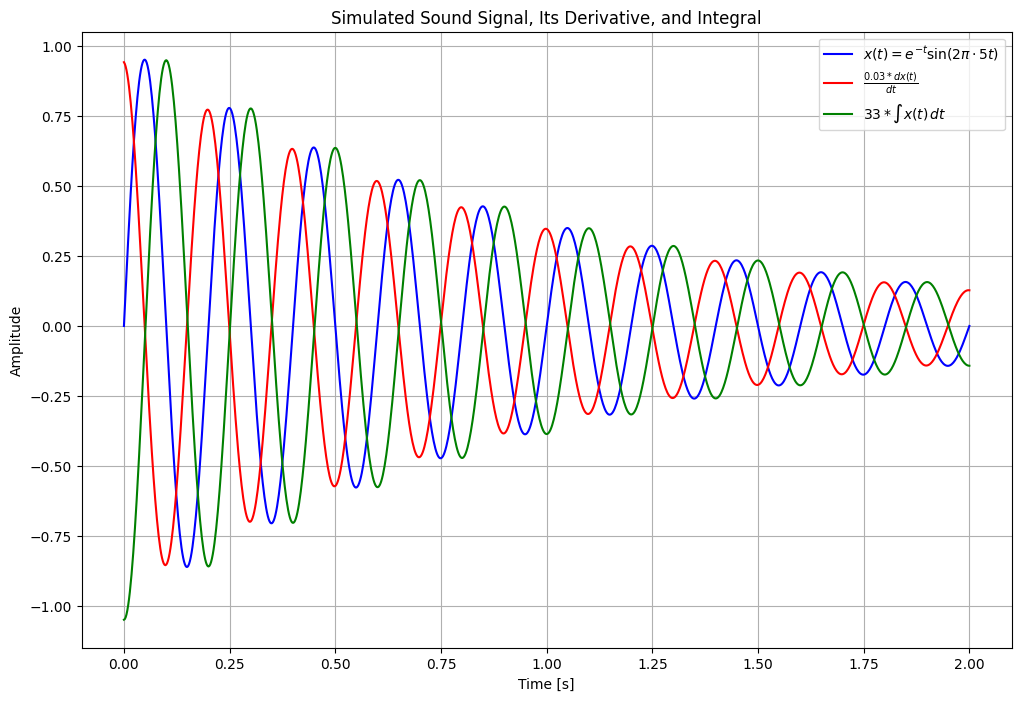
Miniproject: Read speech and manipulate it#
Image Gray value Signal#
\[
x: \mathbb{R}^2 \to \mathbb{R}^1
\]
import numpy as np
import matplotlib.pyplot as plt
from scipy.io import wavfile
from scipy.ndimage import convolve
from skimage.color import rgb2gray
# Simple derivative kernel for the x-axis (central difference)
#dx_kernel = np.array([[-1, 0, 1]]).reshape(1, 3)
dx_kernel = np.array([[-1, 0, 1],[0,0,0],[-1,0,1]])
# Read an image (replace with your image path)
image_gray = plt.imread('6.jpg') # Replace with your image path
image_gray = rgb2gray(image_gray)
# Apply the kernel to compute the derivative in the x direction
dx_simple = convolve(image_gray.astype(float), dx_kernel)
# Plot the original and derivative images
plt.figure(figsize=(12, 6))
# Original image
plt.subplot(1, 2, 1)
plt.imshow(image_gray, cmap='gray')
plt.title('Original Image')
plt.axis('off')
# Derivative along x-axis
plt.subplot(1, 2, 2)
plt.imshow(dx_simple, cmap='gray')
plt.title('Derivative along x-axis (d/dx)')
plt.axis('off')
plt.show()
---------------------------------------------------------------------------
ModuleNotFoundError Traceback (most recent call last)
Cell In[2], line 5
3 from scipy.io import wavfile
4 from scipy.ndimage import convolve
----> 5 from skimage.color import rgb2gray
8 # Simple derivative kernel for the x-axis (central difference)
9 #dx_kernel = np.array([[-1, 0, 1]]).reshape(1, 3)
10 dx_kernel = np.array([[-1, 0, 1],[0,0,0],[-1,0,1]])
ModuleNotFoundError: No module named 'skimage'
Image RGB Signal#
\[
x: \mathbb{R}^2 \to \mathbb{R}^3
\]
import numpy as np
import matplotlib.pyplot as plt
from scipy.ndimage import convolve
# Define simple Sobel-like kernels for x and y gradients
dx_kernel = np.array([[-1, 0, 1],
[-1, 0, 1],
[-1, 0, 1]])
dy_kernel = np.array([[-1, -1, -1],
[0, 0, 0],
[1, 1, 1]])
# Load the RGB image
image = plt.imread('6.jpg')
# Ensure the image is in RGB format (3 channels)
if len(image.shape) != 3 or image.shape[2] != 3:
raise ValueError("Image should be in RGB format")
# Apply convolution to each channel for x and y gradients
grad_x = np.zeros_like(image, dtype=float)
grad_y = np.zeros_like(image, dtype=float)
for i in range(3): # Iterate over RGB channels
grad_x[..., i] = convolve(image[..., i].astype(float), dx_kernel)
grad_y[..., i] = convolve(image[..., i].astype(float), dy_kernel)
# Compute gradient magnitude across all channels
grad_magnitude = np.sqrt(np.sum(grad_x**2 + grad_y**2, axis=-1))
# Plotting the results
plt.figure(figsize=(10, 5))
# Original image
plt.subplot(1, 2, 1)
plt.imshow(image)
plt.title('Original RGB Image')
plt.axis('off')
# Gradient image (combined magnitude across RGB channels)
plt.subplot(1, 2, 2)
plt.imshow(grad_magnitude, cmap='gray')
plt.title('Combined Gradient Magnitude (RGB)')
plt.axis('off')
plt.show()

ECG Signal#
\[
x: \mathbb{R}^{12} \to \mathbb{R}^1
\]
12-Lead ECG Channels: 12 Description: The standard clinical ECG with 12 different leads, providing a comprehensive view of the heart’s electrical activity from different angles. It includes:
3 Bipolar Limb Leads: I, II, III
3 Unipolar Limb Leads: aVR, aVL, aVF
6 Precordial (Chest) Leads: V1, V2, V3, V4, V5, V6
import neurokit2 as nk
import matplotlib.pyplot as plt
import pandas as pd
import numpy as np
# Generate a synthetic heart rate signal
ecg=nk.ecg_simulate(duration=5, sampling_rate=1000, heart_rate=80)
signals, info = nk.ecg_process(ecg, sampling_rate=1000)
nk.ecg_plot(signals, info)
ecg = np.array(pd.read_csv("ecg_1000hz.csv"))
subset_ecg = ecg[:2500, 0] # Select the first 100 samples
ecg_df = pd.DataFrame(subset_ecg, columns=['ECG'])
#nk.signal_plot(ecg)
nk.signal_plot(ecg_df, title="Subset of ECG Data (100 Samples)")
plt.show()
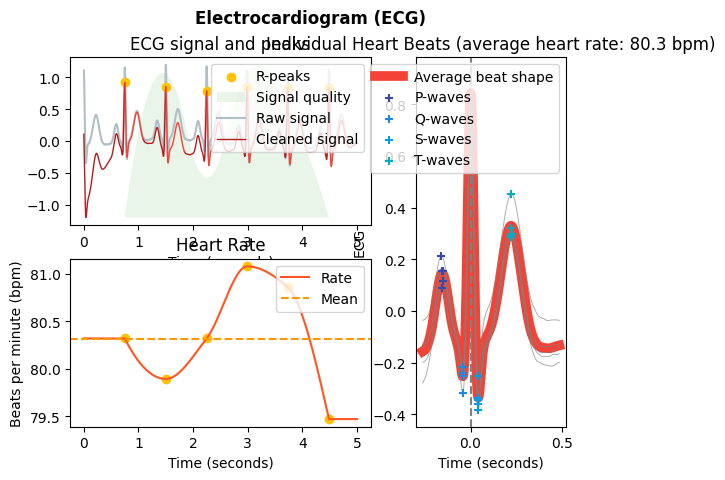
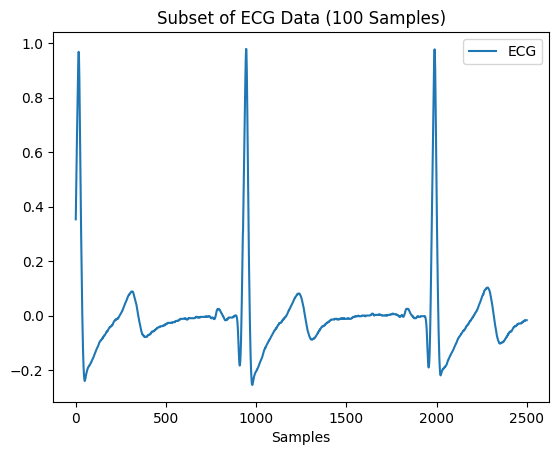
Discrete Signal#
import numpy as np
import matplotlib.pyplot as plt
# Discrete signal function: x[n] = 2^n
n_values = np.arange(-5, 6) # From n = -5 to n = 5
x_values = [2.0**n for n in n_values]
# Plot the discrete signal
plt.stem(n_values, x_values)
plt.title("Discrete Signal: $x[n] = 2^n$")
plt.xlabel("n")
plt.ylabel("$x[n]$")
plt.grid(True)
plt.show()
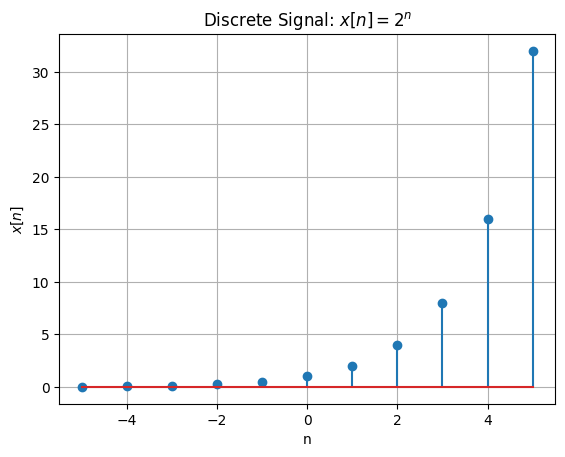
import sympy as sp
import numpy as np
import matplotlib.pyplot as plt
from sympy import cos
# Step 1: Define the discrete variable
n = sp.symbols('n', integer=True)
# Step 2: Define the discrete signal (for example, x[n] = 2^n)
x_n = 1.03**(-n)*cos(np.pi/12*(n-0))
# Step 3: Generate the sequence of values for n (e.g., from -5 to 5)
n_values = np.arange(0, 92)
# Step 4: Convert the symbolic expression to numerical values
# Use SymPy's lambdify to convert the expression to a numeric function
x_n_func = sp.lambdify(n, x_n, 'numpy')
# Step 5: Evaluate the function for the range of n_values
x_values = x_n_func(n_values)
# Step 6: Plot the discrete signal
plt.stem(n_values, x_values)
plt.title(f"Discrete Signal: ${sp.latex(x_n)}$")
plt.xlabel("n")
plt.ylabel("$x[n]$")
plt.grid(True)
plt.show()
print(x_n)
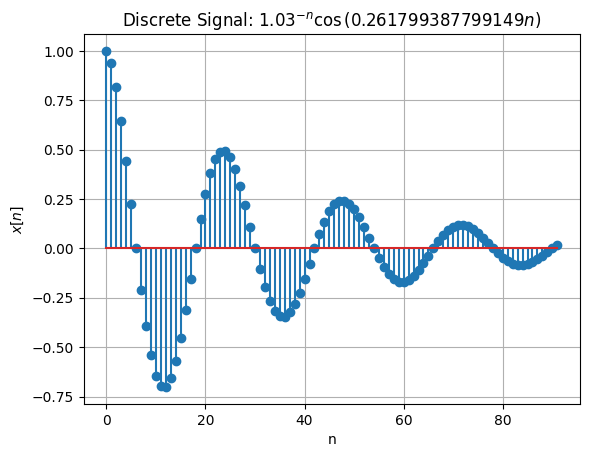
cos(0.261799387799149*n)/1.03**n
